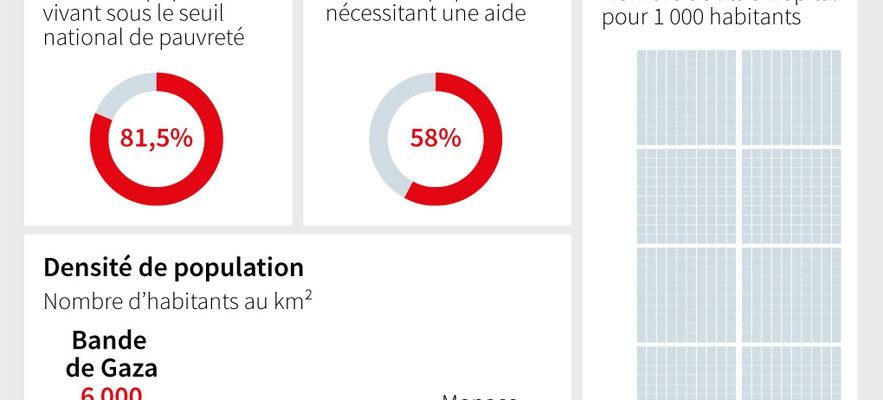20 trucks, which could be followed by a hundred others. Humanitarian aid should begin to be delivered to Gaza from this Friday, October 20, following an agreement reached between American President Joe Biden and his Egyptian counterpart Abdel-Fattah al-Sissi. It should pass through the Rafah crossing, which is today the only opening into the Gaza Strip that is not controlled by Israel.
Israel’s response to the bloody Hamas terrorist attack on its soil has accentuated an already very difficult humanitarian situation for the inhabitants of Gaza. Indeed, according to the UN and the Palestinian Bureau of Statistics, nearly 81.5% of the population of Gaza today lives below the poverty line. 58% of the more than two million Gazans would also need humanitarian aid in order to survive.
The Gaza Strip
© / afp.com/Clement KASSER, Laurence SAUBADU
Access to basic needs is also very difficult in the Gaza Strip. Even before the Israeli counterattack, Gazans only had access to electricity six to seven hours a day. Israel’s “complete siege” of the territory was accompanied by a complete power cut in northern Gaza. This Thursday, the charge d’affaires at the Israeli embassy in France declared on Franceinfo that the return of electricity to the territory is conditional on the Red Cross being able to benefit from the right of access and visit to the hostages held by Hamas in Gaza. Thus putting part of the region’s humanitarian future in the hands of the Islamist organization.
These power cuts make it almost impossible for health services to operate. The few hospitals, already largely insufficient to cover the needs of one of the most densely populated territories in the world, are under very strong pressure, accentuated by the deadly strike in the region’s main hospital this Tuesday evening. And this, while the Ministry of Health of the Hamas government in Gaza recorded this Thursday more than 12,000 injured since the start of the war on October 7.
Very difficult access to water
Access to drinking water is also very difficult for Gazans. The UN estimates that 90% of the water available in Gaza is unfit for consumption. A situation aggravated by the blockade led by Israel: the UN Office for the Coordination of Humanitarian Affairs estimated in a report published on October 16 that “the average consumption of water, all sources combined and for all needs, has fallen to only three liters per day and per person”, with the consequence of aggravating “fears of dehydration and the appearance of illnesses of water origin, including cholera.
The start of the delivery of this humanitarian aid from this Friday, even if this date still remains uncertain at this time, should make it possible to provide vital resources to Gazans. However, it remains insufficient for the moment, the World Health Organization ruled this Thursday. She asked that this aid be able to “enter Gaza every day” in order to meet the needs of the population.
